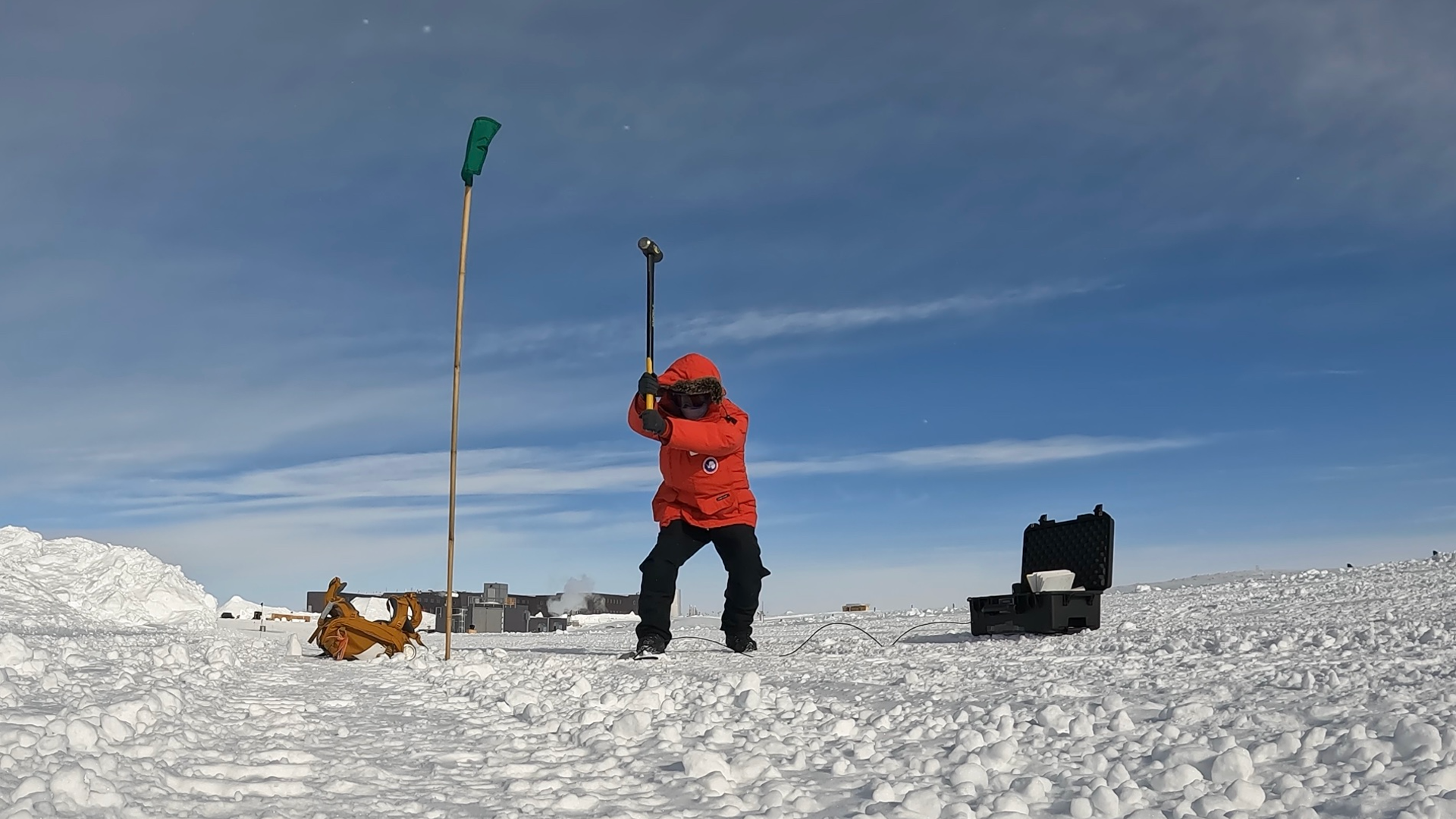- About
- Network
- Community
- Initiatives
- News
- Events
- Blog
- Publications

CENIC Recognizes Caltech’s Zhan Group of Observational Seismology for Research on Fiber-optic Cables as Seismic Sensor Nets
CENIC is pleased to announce that the 2024 Innovations in Networking Award for Experimental Applications will be awarded to the Zhan Group of Observational Seismology, led by California Institute of Technology Professor of Geophysics Zhongwen Zhan. This award recognizes exemplary people, projects, and organizations that leverage high-bandwidth networking.
The Zhan Group of Observational Seismology is recognized for its work demonstrating how fiber-optic cables – including submarine cables – can be used as vast and cost-effective seismological sensor nets.
Currently in quake-prone California, there are only about 500 seismometers distributed throughout the third largest state in the union, with each costing tens of thousands of dollars and requiring networking, often in remote areas. Thanks to the Zhan Group’s research, the microscopic imperfections in the fiber-optic cables already in use throughout the state and the world have been transformed into millions of already networked individual seismometers needing scientific equipment only at the endpoints that sense tiny movements of the Earth’s crust, giving scientists an unprecedented, detailed real-time view of ground and ocean movement and fault structures.
“We are impressed by the Zhan Group’s ability to leverage existing infrastructure to enhance seismic sensing capabilities,” stated Louis Fox, CENIC’s Chief Executive Officer. “This approach not only optimizes resources but also exemplifies the kind of forward-thinking and practical application of technology that aligns perfectly with CENIC's mission.”
“We greatly appreciate the recognition from CENIC,” said Professor Zhan when he learned of the award. “It is exciting to be able to rapidly expand seismic networks, and the support from the telecom cable industry is what makes our research possible. We hope to become the bridge between the geoscience community and the telecom industry represented by CENIC to bring about more insight into the Earth’s behavior.”
From Hundreds of Seismic Sensors to Millions: How It’s Done
The idea of using the imperfections in fiber-optic cables to sense ground movement is not a new idea. As early as the 1970s, it was posited when researchers and engineers first realized that such movements caused perturbations in the signals sent along the cables. The idea of using these perturbations as ground movement sensors quickly followed.
The tiny imperfections in fiber-optic strands used in the Zhan Group’s research do not interfere with the transmission of data along the cables, but they do reflect back exceedingly small amounts of light. These tiny flashes of light can be used to detect when the strand – the cable itself – moves and by how much via installing a laser emitter at one end and measuring changes in the round-trip time of various flashes caused by the imperfections.
Zhan explains the basic technology in this short YouTube video.

Identifying and Monitoring Risky Areas with Fiber-Optic Cables: California’s Long Valley Caldera
The US West Coast – including California but not exclusively – is globally known for its seismic activity. An example of how the Zhan Group’s research has shed light on pressing questions about current risk levels can be found in their recent publication “An upper-crust lid over the Long Valley magma chamber.”
A caldera is an extremely large depression in the ground over an underground magma chamber. Some calderas can cover very large areas of land and have been the sites of cataclysmic supervolcano eruptions in the distant past. One such caldera is the Long Valley Caldera 200 miles east of San Francisco, formed in a massive explosion three-quarters of a million years ago that spread ash as far east as the Great Plains.
This area began troubling scientists when it first rumbled back to life in May 1980, only a few months after the famous eruption of Mount St. Helens in Washington state. Several quakes of magnitude 6 hinted at an increase in seismic activity under the caldera, and given its proximity to areas of high population and economic importance, better insight was vital.
Thanks to the use of distributed acoustic sensing data recorded along a 100-kilometer fiber-optic cable traversing the caldera, the Zhan Group was able to image its subsurface structure. Their images were able to show a clear distinction between a shallow – and active – hydrothermal system that appears responsible for the quakes versus the much deeper large magma chamber. In other words, the quakes were caused not by magma shifting in preparation for an eruption but by other less ominous shifting fluids, such as high-pressure boiling water.
Zhan’s South Pole Trip Hints at Promise of this Technology for Glacier Study
With awareness of the consequences of global warming increasing daily, scientists in multiple fields are extremely interested in the behavior of the relatively few remaining glaciers around the world. Antarctica is of particular interest since it lies under a sheet of ice averaging nearly a mile and a half thick that, in some places, is rapidly melting and threatening significant sea level rise. Understanding the movements of glaciers could be an important part of infrastructure planning and other activities as the globe warms in the coming century.
To study whether fiber-optic cables could be put to this use on the world’s southernmost continent, Zhan and colleagues traveled to the US Amundsen-Scott Station at the South Pole in 2023, where an unused fiber-optic cable connecting the station to another research installation lay under more than 10 meters of ice. Using this cable, strikes from a normal sledgehammer could be detected over a kilometer away, and those of a stronger mechanical hammer could be detected over 10 km away.

Ease of Installation Can Turn Submarine Cables into Marine Sensors
Significantly, this application does not require any additional equipment along the length of the cables, but only at either end. This makes it much much easier for researchers to use these cables for seismic research, given that the cables’ owners need not be persuaded to permit the installation or colocation of equipment at huts or access points along the cables’ length.
It also enables the use of undersea cables, which are inaccessible along their lengths in normal circumstances, to gain insight into sea floor and ocean movement. Nearly three quarters of the Earth’s surface is covered by water, and installing dedicated undersea seismic sensors is prohibitively expensive and difficult. The application of this technology to the three-quarters of a million miles of existing submarine cables can provide invaluable early warning of sea floor movement that could trigger tsunamis, even enabling shutdowns or other preventive measures in sensitive coastal installations like nuclear plants, wind farms, other power stations, and more.
One such example using pre-existing undersea cables is that of a 40 km fiber-optic cable used by a wind farm located in the North Sea to connect the installation to land. Thanks to this project, Zhan and colleagues were able to validate a theory first posed in the 1950s that sea floor movement doesn’t just cause ocean movement, but the other way around as well: ocean waves can cause small tremors in the sea floor.
Not only that, but Zhan and colleagues also made use of a 10,500 km long cable owned by Google and connecting Los Angeles to Valparaíso in Chile. Not only could the cable sense earthquakes but it was also able to sense storm-drive ocean movement.
Other scientists have even posited the use of fiber-optic cables as sensors on the lunar surface, hinting that the promise of this research is more far-reaching than even the experts can conceive presently.
Related blog posts
Solving Network Connections for USC on Catalina Island
CalREN connection and resiliency for USC's Wrigley Institute for Environmental Studies and its Marine Science Center on Catalina Island
Network Traffic Analysis Shows Changing Activity Patterns During COVID-19 Pandemic
Even as campuses, schools, libraries, and cultural institutions have closed amid stay-at-home orders, CENIC’s networks have remained a vital part of the Internet ecosystem for online learning and community engagement, remote access to research data and specialized computing facilities, academic medicine and clinical care, and work-from-home operations.


